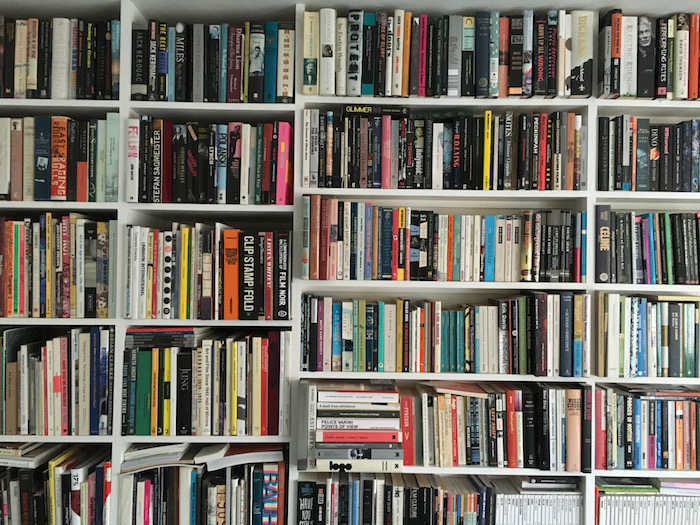
I’m a publisher, author, editor, and occasional designer of printed books. And I’m doing this at a time when the primacy of the printed book — that centuries old fulcrum of world culture — has been challenged by the arrival of e-books, e-readers, and electronic publishing of all kinds. Challenged, yes. But diminished, no. In fact, I’d argue that electronic publishing’s failure to establish a more emotionally satisfying alternative to the printed book has enhanced the status of physical books.
I say this from the biased position of a serial accumulator of printed books, and as an unwavering admirer of the sheer efficiency of the book to deliver most forms of information — especially in the field of art and design, where it seems to me that no electronic rival has even come close to the expansiveness and generosity of the printed page when arranged sequentially and bound within a protective cover.
I’m with Umberto Eco when he says: “The book is like the spoon, scissors, the hammer, the wheel. Once invented, it cannot be improved. You cannot make a spoon that is better than a spoon... The book has been thoroughly tested, and it’s very hard to see how it could be improved on for its current purposes.”
None of this means that I’m in any way anti-electronic publishing. Life without electronic publishing — websites, blogs, Twitter feeds, search engines, etc. — is unthinkable. And like many people I embraced the reading of text on the iPad with gusto: No more sagging bookshelves; no more lugging around 900pp tomes; and almost the entire cosmos of published texts — everything from Beowulf to Jonathan Franzen — only ever a keystroke away.
I still read continuous text on my iPad, but less often than I used to, and with less relish. Consequently, dozens of downloaded books that I own (if “owning” is even the correct terminology) are no more than unread ghost texts residing undisturbed in various vaporous cyber clouds.
What does this mean? Am I a print-sniffing curmudgeon? A sad sack bibliophile pining for a soon to be vanished world of bookishness? Or am I, as a non-digital native, simply too embedded in print culture to embrace new ways of reading? Perhaps, but it seems I’m not alone. According to the Association of American Publishers: “E-book sales fell by 10 percent in the first five months of this year.” And in the UK “Figures released by Nielsen Bookscan show sales of print books for the first 36 weeks of 2015 rose by 4.6% (worth £739.5m) when compared to the same period in 2014.”
Why is this happening? The “institutional theory of art” was posited by the art philosopher George Dickie. He wrote: “a work of art in the classificatory sense is 1) an artifact 2) on which some person or persons acting on behalf of a certain social institution (the artworld) has conferred the status of candidate for appreciation.” If we apply the institutional theory to physical books we see that even a moderately well produced printed book carries an authority that is almost universally recognized. Printed books come to us via a retinue of experts: authors, editors, agents, designers, typesetters, printers, binders, distributors, booksellers, reviewers and, of course, publishers. This imparts a whiff of authority to even the lowliest of printed books, and it does this because physical books are still the main repository of “publishingworld” credibility. This is not always true of blogs and other modes of electronic text-based publishing where what we often value is the freedom from “publishingworld” conventions.
But if it can be successfully argued that the book retains its primacy, it can no longer be said that publishing is the sole preserve of the book. As Clay Shirkey has memorably noted: “Publishing is not evolving. Publishing is going away. Because the word ‘publishing’ means a cadre of professionals who are taking on the incredible difficulty and complexity and expense of making something public. That’s not a job anymore. That’s a button. There’s a button that says ‘publish,’ and when you press it, it’s done.”
In other words, the “publishing world” gatekeepers have abandoned their posts and anyone can publish – and for anyone with an interest in the dissemination of ideas, information, and alternative viewpoints, the new publishing landscape is a godsend. But it doesn’t alter the fact that the printed book offers a more satisfying reading experience than most forms of electronic publishing.
Books of course are not perfect. They have weak points. From the time they leave an author’s hands, they take too long to reach readers; they cannot easily be updated or amended; and they are expensive to manufacture and distribute. These are all factors that electronic publishing is better at dealing with than printed books.
But until electronic publishing finds a way to rival the multisensory experience of reading even a modestly produced physical book, it will continue to provide only a second rate reading experience, and the death of the book will be postponed once more.
This essay was originally published in January 2016.


Comments [5]
01.04.16
10:54
01.04.16
11:17
01.04.16
01:06
01.06.16
07:23
01.10.16
01:02